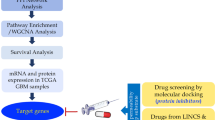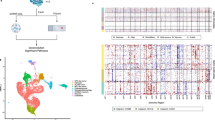Abstract
Primary lymphomas of the central nervous system (PCNSL) are highly aggressive tumors affecting exclusively the CNS, meninges, and eyes. PCNSL must be separated from secondary spread of systemic lymphoma to the CNS (SCNSL), which may occur at diagnosis or relapse of systemic lymphomas. At present, there are no valid methods to distinguish PCNSL from SCNSL based on tumor biopsy because of similar histological presentation. However, SCNSL and PCNSL are different in terms of prognosis and adequate therapy protocols. MicroRNA expression profiles of CSF samples collected from SCNSL and PCNSL patients were compared using microRNA arrays. MiR-30c revealed the largest differential expression and was selected for validation by RT-PCR on 61 CSF samples from patients with PCNSL and 14 samples from SCNSL. MiR-30c was significantly increased in patients with SCNSL compared to PCNSL (p < 0.001). MiR-30c levels in CSF enabled the differentiation of patients with PCNSL from SCNSL with an area under the curve (AUC) of 0.86, with a sensitivity of 90.9% and a specificity of 85.5%. Our data suggest that miR-30c detected in the CSF can serve as biomarker for distinction between PCNSL and SCNSL. The validation in a larger cohort is needed. With respect to its function, miR-30c may facilitate lymphoma cells to engraft into CNS by interaction with CELSR3 gene that controls the function of ependymal cilia and, thus, affects the circulation of CSF.

Similar content being viewed by others
References
Ney DE, Deangelis LM (2010) Management of central nervous system lymphoma. In: Armitage JO, Mauch PM, Harris NL, Coiffier B, Dalla Favera R (eds) Non-Hodgkin lymphomas. Lippincott Willilams & Wilkins, Philadelphia, pp 527–539
Shenkier TN, Blay JY, O’Neill BP et al (2005) Primary CNS lymphoma of T-cell origin: a descriptive analysis from the international primary CNS lymphoma collaborative group. J Clin Oncol 23:2233–2239
Deckert M, Paulus W, Kluin PM et al (2016) Lymphomas. In: World Health Organization histological classification of tumours of the central nervous system, 4th revised edn. pp 271–283
Ferreri AJ, Assanelli A, Crocchiolo R et al (2009) Central nervous system dissemination in immunocompetent patients with aggressive lymphomas: incidence, risk factors and therapeutic options. Hematol Oncol 27:61–70
Schmitz N, Zeynalova S, Glass B et al (2012) CNS disease in younger patients with aggressive B-cell lymphoma: an analysis of patients treated on the Mabthera International Trial and trials of the German High-Grade Non-Hodgkin Lymphoma Study Group. Ann Oncol 23(5):1267–1273
Doolittle ND, Abrey LE, Shenkier TN et al (2008) Brain parenchyma involvement as isolated central nervous system relapse of systemic non-Hodgkin lymphoma: an international primary CNS lymphoma collaborative group report. Blood 111(3):1085–1093
Akkas BE, Vural GU (2013) The incidence of secondary central nervous system involvement in patients with non-Hodgkin’s lymphoma as detected by 18F-FDG PET/CT. Nucl Med Commun 34(1):50–56
Korfel A, Schlegel U (2013) Diagnosis and treatment of primary CNS lymphoma. Nat Rev Neurol 9(6):317–327
Korfel A, Chamberlain M, Neuwelt E et al (2016) Therapy for secondary CNS involvement in malignant lymphomas: no standard yet! J Clin Oncol 34(15):1829–1830
Baraniskin A, Kuhnhenn J, Schlegel U et al (2011) Identification of microRNAs in the cerebrospinal fluid as marker for primary diffuse large B-cell lymphoma of the central nervous system. Blood 117(11):3140–3146
Baraniskin A, Kuhnhenn J, Schlegel U et al (2012) MicroRNAs in cerebrospinal fluid as biomarker for disease course monitoring in primary central nervous system lymphoma. J Neurooncol 109(2):239–244
Marabita F, de Candia P, Torri A et al (2016) Normalization of circulating microRNA expression data obtained by quantitative real-time RT-PCR. Brief Bioinform 17(2):204–212
Cogswell JP, Ward J, Taylor IA et al (2008) Identification of miRNA changes in Alzheimer’s disease brain and CSF yields putative biomarkers and insights into disease pathways. J Alzheimers Dis 14(1):27–41
Baraniskin A, Kuhnhenn J, Schlegel U et al (2012) Identification of microRNAs in the cerebrospinal fluid as biomarker for the diagnosis of glioma. Neuro Oncol 14(1):29–33
Fischer L, Hummel M, Korfel A et al (2011) Differential micro-RNA expression in primary CNS and nodal diffuse large B-cell lymphomas. Neuro Oncol 13(10):1090–1098
Baraniskin A, Birkenkamp-Demtroder K, Maghnouj A et al (2012) MiR-30a-5p suppresses tumor growth in colon carcinoma by targeting DTL. Carcinogenesis 33(4):732–739
Chang TC, Yu D, Lee YS et al (2008) Widespread microRNA repression by Myc contributes to tumorigenesis. Nat Genet 40:43–50
Kong X, Xu X, Yan Y et al (2014) Estrogen regulates the tumour suppressor MiRNA-30c and its target gene, MTA-1, in endometrial cancer. PLoS ONE 9:e90810
Rodriguez-Gonzalez FG, Sieuwerts AM et al (2011) MicroRNA-30c expression level is an independent predictor of clinical benefit of endocrine therapy in advanced estrogen receptor positive breast cancer. Breast Cancer Res Treat 127:43–51
Wu F, Zhu S, Ding Y et al (2009) MicroRNA-mediated regulation of Ubc9 expression in cancer cells. Clin Cancer Res 15:1550–1557
Budhu A, Jia HL, Forgues M et al (2008) Identification of metastasis-related microRNAs in hepatocellular carcinoma. Hepatology 47(3):897–907
Wang XJ, Zhang DL, Xu ZG et al (2014 Dec) Understanding cadherin EGF LAG seven-pass G-type receptors. J Neurochem 131(6):699–711
Tissir F, Qu Y, Montcouquiol M, Zhou L et al (2010) Lack of cadherins Celsr2 and Celsr3 impairs ependymal ciliogenesis, leading to fatal hydrocephalus. Nat Neurosci 13(6):700–707
Fletcher CD, Kahl B (2014) Central nervous system involvement in diffuse large B-cell lymphoma: An analysis of risks and prevention strategies in the post-rituximab era. Leuk Lymphoma 55:2228–2240
Schmitz N, Zeynalova S, Nickelsen M et al (2016) CNS international prognostic index: a risk model for CNS relapse in patients with diffuse large B-cell lymphoma treated with R-CHOP. J Clin Oncol 34(26):3150–3156
Acknowledgements
The authors thank Andrea Reinert for the excellent technical assistance.
Funding
This study was supported by the a Grant from the Ruhr-University of Bochum (FORUM), and by a Grant (PURE) from the Ministry of Science, North Rhine-Westphalia, Germany and by de.NBI, a project of the German Federal Ministry of Education and Research (BMBF).
Author information
Authors and Affiliations
Contributions
MC, AB, TG, MB performed the experiments. GA, JK, MM, US collected clinical samples. MT and ME. analyzed the results statistically, AB, MC, SH, US, WS and RS designed the research. AB, RS analyzed the results and wrote the paper.
Corresponding authors
Ethics declarations
Conflict of interest
The authors declare no competing financial interest.
Electronic supplementary material
Below is the link to the electronic supplementary material.
Rights and permissions
About this article
Cite this article
Baraniskin, A., Chomiak, M., Ahle, G. et al. MicroRNA-30c as a novel diagnostic biomarker for primary and secondary B-cell lymphoma of the CNS. J Neurooncol 137, 463–468 (2018). https://doi.org/10.1007/s11060-018-2749-0
Received:
Accepted:
Published:
Issue Date:
DOI: https://doi.org/10.1007/s11060-018-2749-0




